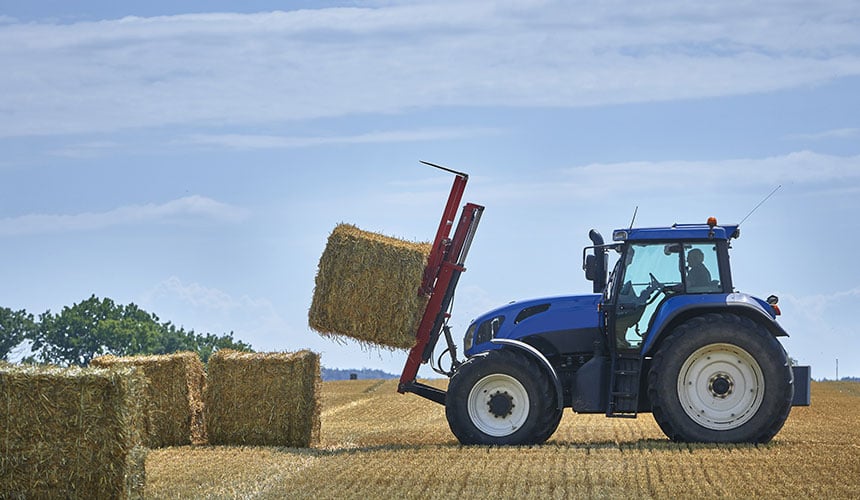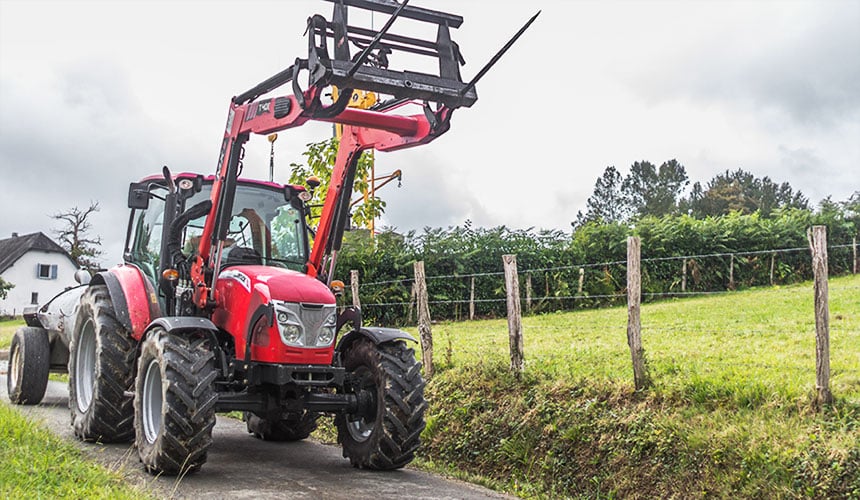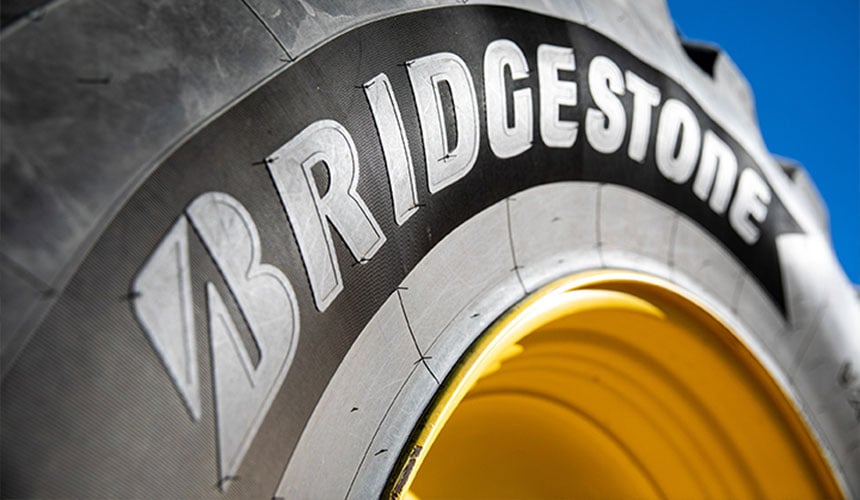Mixed crop-livestock farming work requires more versatile tyres for your tractors than field crop farming alone. During manoeuvres in the farm courtyard, your tyres effectively face a tough task on hard ground with a significant load transfer to the front of the machine if you use a front loader.
You also have to work in the fields to complete your activity and your tyres must once again adapt to a very different environment working on soft ground, while avoiding overly compacting the soil. With these differing demands, you must take account of the reality of the work to be carried out when you replace your tyres.
In addition to being able to work at low pressure, your new tyres must be capable of coping with a high load capacity at the front.
This article provides explanations that will help you to take better account of the front load transfer for your farming activity.
1. Why can’t you use any tyre for mixed crop-livestock farming?
With mixed crop-livestock farming, you have to adapt to different activities which do not have the same technical demands.
For work in livestock buildings, with narrow alleys or passages under relatively low frames, a telescopic forklift is well suited, whereas a powerful tractor is better adapted to work in the fields.
For the tyres, it’s exactly the same principle; resistant tyres that can cope with high pressure for work on hard ground and very supple tyres capable of working at low pressure for the fields.
Yet not all farms are able to have a fleet with a vehicle dedicated to each activity. If you have chosen to use a 100 or 115 hp tractor for work in the fields, it will also be perfectly operational with a front loader for all handling work.
On the other hand, for the tyres, you must choose carefully, and select tyres that can work at a wide range of inflation pressures to manage the different activities without having to change equipment regularly.
Efficient tyres for handling with a front loader
During loading, unloading or on-the-spot manoeuvres in the farm courtyard and livestock farming buildings, the front tyres are placed under considerable strain by the load transfer linked to the use of a front loader.
By opting for radial tyres with a reinforced casing and a large number of plies used to produce the tread and sidewalls, you will have a tyre model that is well adapted to handling operations.
These tyres must be able to work at a higher inflation pressure to improve stability during lifting manoeuvres. They must be resistant to lateral strain during loading manoeuvres.

in mixed crop livestock farming
Tyres that can work at low pressure with a tread that is optimised for traction
On the other hand, your tyres must also be suitable for all types of field operations: haymaking, hoeing, spraying, tilling or sowing.
They must be able to work at low pressure, giving them a larger contact patch with the ground to improve traction, especially on loose soil, in wet conditions.
The more your tyres are able to transmit tractive force to the ground, the less they will slip and the more time will be saved. In addition, you will be able to save fuel while improving your daily productivity.
Tyres have a major impact on soil compaction in your fields.
If you work with tyres that are too rigid, intended for use in handling operations, you are likely to compact your soil, thus reducing yields in future years.
Unless you are prepared to change tyres each time you change activity, it may be in your interest to opt for multipurpose tyres which can be used at a very wide range of pressures varying from 0.8 bar to 2.4 bar.
2. How to manage the load transfer to the front axle?
When you use a tractor equipped with a front loader, the load transfer to the front axle changes cyclically in line with loading and unloading operations.
This makes pressure settings uncertain and highly dependent on the type of handling operation to be carried out: transporting fodder to feed the cattle, high storage of hay or loading organic waste into a trailer….
Each operation has different load requirements.

Whatever the type of task to be carried out with a front loader, you need to think about balancing out the load transfer to the front axle by compensating with metal mass ballast on the tractor’s rear lift.
Good ballasting at the rear makes it possible to compensate for the imbalance during lifting with a heavy load at the end of the boom arm. This spreads out the load per axle and relieves the compression effect on the front axle, thus improving the tractor’s stability.
Here are some examples of equipment setups which allow for the possibility of a load bonus on the front loader using multipurpose tyres:
EXAMPLE 1: New Holland NH 8260 - 115 HP
- Tyre dimensions: Front 380/85 R28 VX-TRACTOR 139D – Rear 460/85 R38 VT-TRACTOR 154D
- Tractor weight distribution: Front 2,040 kg – Rear 2,940 kg
- Reference loader: MX T408+. Data and loads as indicated by the manufacturer
- Weight of the loader: 490 kg – PULL-OUT FORCE at the loader’s rotational axis 2,400 kg

- Total weight on the front axle: 2,400 kg + load transfer (× 1.9) = 4,560 kg + Front weight of the tractor 2,040 = 6,600 kg
- Take into account the transfer of weight to the rear axle of the tractor thanks to ballast weight on the tractor’s rear lift, i.e. 500 kg less on the front, for a weight of 1,000 kg:
6,600 – 500 kg = 6,100 kg, i.e. an expected load capacity of 3,050 kg per tyre. - The real load capacity of these front tyres is 3,270 kg with a front tyre pressure of 1.8 bar at 10 km/h for cyclic use.
Our advice for this equipment setup
- This also enables cyclic use at 15 km/h.
- This will lead to a decrease in the deflection area (the tyre flattens out less on the ground), more rigidity at the level of the sidewalls and therefore a lower risk of damage or cuts to the sidewalls.
- The overall behaviour of the casing and the tread will be better with good stability during lifting.
EXAMPLE 2: Massey Ferguson 5710 SL – 100 HP
- Tyre dimensions: Front 340/85 R28 VX-TRACTOR 133D – Rear 420/85 R38 VX-TRACTOR 149D
- Tractor weight distribution: Front 1,800 kg – Rear 1,920 kg
- Reference loader: MX T408. Data and loads as indicated by the manufacturer
- Weight of the loader: 480 kg - PULL-OUT FORCE at the loader’s rotational axis 2,100 kg

- Total weight on the front axle: 2,100 kg + load transfer (× 1.9) = 3,990 kg + front weight of the tractor 1,800 kg = 5,790 kg
- Take into account the transfer of weight to the rear axle of the tractor thanks to ballast weight on the tractor’s rear lift, i.e. 400 kg less on the front, for a weight of 800 kg:
5,790 – 400 = 5,390 kg on the front axle, i.e. an expected load capacity of 2,695 kg per tyre. - The real load capacity of these front tyres is 2,790 kg with front tyre pressure of 1.8 bar at 10 km/h.
Our advice for this equipment setup
- This also enables cyclic use at 15 km/h.
- This will lead to a decrease in the deflection area (the tyre flattens out less on the ground), more rigidity at the level of the sidewalls and therefore a lower risk of damage or cuts to the sidewalls.
- The overall behaviour of the casing and the tread will be better with good stability during lifting.
3. Why adapt pressure settings based on the activity?
As there is a broad range of activities involved in mixed crop-livestock farming, it is necessary to work with tyres that are highly resistant for manoeuvres in the farm courtyard on harder surfaces; but at the same time be able to work at low pressure in the fields to optimise your traction capacity and preserve your soil.
In order to manage the load transfer onto the front tyres of your tractor properly, you must also choose the right pressure settings for the activity to be carried out.
There are basically three ranges of inflation pressure to choose from, with the possibility of varying pressure based on the exact load carried by your equipment.
Three ranges of inflation pressure to protect your tyres from wear:
- 2.2 bar or more if possible for handling operations with a front loader to avoid rapid wear: increasing pressure to 2.2 bar allows you to carry more load and ensures better stability on hard ground.
- 1.6 to 2 bar for the road: this is the average inflation pressure to optimise your agricultural tyres’ lifespan with regular use on the road. As the asphalt is a hard, very abrasive surface, you must not drive with a low inflation pressure to avoid premature damage at the level of the tread, especially when driving at speed.
- 0.8 to 1.1 bar for work in the fields: on soft soil, the opposite applies, because you must reduce pressure to avoid soil compaction. By reducing pressure to 1.1 bar, you obtain a large contact patch, less slip and optimal tractive force.

Multipurpose use in mixed crop-livestock farming
4. What is the most suitable tyre for use in mixed crop-livestock farming?
There are several tyre models dedicated to mixed crop-livestock farming work, but Bridgestone’s VX-TRACTOR stands apart due to its exceptional characteristics.
This top-of-the-range tyre has a reinforced casing designed to resist the different types of strain placed on the tyre during handling operations and travel by road, but it is also equipped with lugs that are longer than those of the other tyres on the market. This gives it a true advantage in terms of traction for work in the fields.

Advantages of the VX-TRACTOR tyre for mixed crop-livestock farming
- This tyre range has been specially designed for farmers who use their tractors for multiple different purposes.
- The VX-TRACTOR is currently the most versatile tractor tyre on the market thanks to its performance capacities and durability.
- The tyre casing is designed to cope with an inflation pressure ranging from 0.6 bar to 2.4 bar, which makes it suitable for each type of use and able to carry heavy loads if your tractor is equipped with a front loader.
- The tread is made up of six layers of superior quality rubber which increases resistance and minimises the effects of erosion and rubbing during use on hard ground.
- This tyre has a high traction capacity and exceptional adherence in all conditions, thanks to its technical design stemming from Bridgestone’s most highly evolved tyre models.
- The VX is designed to last longer thanks to its longer, wider lugs. The volume of rubber used is up to 20% higher than its direct competitors. The vegetable oil compound used in its production makes it more resistant to wear than other tyre models on the market.
This tyre has a robust design, is resistant to wear, versatile and highly efficient.
Its technological design evolutions make it a longer lasting tyre, with a high load capacity and exceptional adherence in the fields.
The Bridgestone-agriculture.eu blog is written and administered by tractor tyre experts who are available to provide you with the advice you need on the subject of your agricultural tyres. They allow you to maximise your productivity with information on all subjects linked to tyres: Cheap tractor tyres — Technical data for agricultural tyres — Air pressure advice — Solutions to avoid soil compaction — Sprayer tyre pressure — Why and how to ballast your tractor tyres — When to use dual wheels — The mechanical causes of abnormal wear — Cheap agricultural tyres – etc.
To learn more and boost your farm's profits, Bridgestone-Agriculture is offering you a free, detailed white paper that explains the essential role your agricultural tyres play in your productivity.
Most people who read this article have also read some of the following articles:
- 5 essential techniques to optimise your agricultural tyres
- Load comparison between standard agricultural tyres and VF tyres
- Impact of the loaded radius for my agricultural tyres
- VF agricultural tyres versus caterpillars: Pros and cons
- Why should you check your harvesting tyres before the start of the harvest?
- Which agricultural tyre makes it possible to avoid coming off the rim at low pressure?
- What is the impact of implement settings on tractor tyres?
- Fleet audit: what is the main benefit of agricultural tyres?
- Do you really use the full capacity of your VF agricultural tyres?
- Agricultural tyres: rules for managing the lead ratio
This information is intended only to make you aware of the technical and functional aspects of agricultural tires and their use. It does not allow you to make a judgment or a definitive conclusion on a given problem. Only your agricultural tire expert is able to make a technical assessment and take a final decision, case by case.
Leave a
commentary
Your email address will not be published.
Required fields are indicated with *








